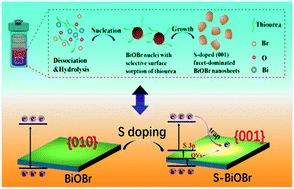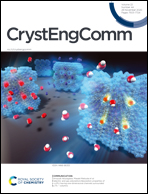Oriented construction of S-doped, exposed {001} facet BiOBr nanosheets with abundant oxygen vacancies and promoted visible-light-driven photocatalytic performance
Abstract
Element doping and crystal engineering are efficient strategies to enhance the photo-reactivity of semiconductors by tuning the physico-chemical properties. Herein, S-doped BiOBr photocatalysts with tunable exposed {001} facets were prepared by a hydrothermal method and characterized by XRD, XRF, BET, FT-IR, SEM, TEM, EDS, XPS, UV-vis DRS, EIS, and EPR. It is revealed that S doping could orient the facet growth of BiOBr nanosheets from the originally exposed {010} plane towards the {001} dominant plane. Thiourea is selected as a “three-in-one” reaction medium, which not only acts as a kind of ligand, a capping agent and an S donor, but also plays a crucial role in the oriented growth of BiOBr nanosheets with exposed {001} facets. The photocatalytic activity of the obtained hybrids is evaluated by oxidizing RhB under visible light irradiation. S-Doped BiOBr catalysts show significant improvement in photocatalytic activity compared with original BiOBr, which is attributed to the synergistic effect of S doping and dominant {001} facet growth, resulting in narrower bandgap energy, more efficient charge separation and higher oxygen vacancy (OV) concentration. This study provides a paradigm of crystal facet control by element doping, and gives a deep insight into the specific surface area and properties determined by element doping and crystal facet engineering.



 Please wait while we load your content...
Please wait while we load your content...